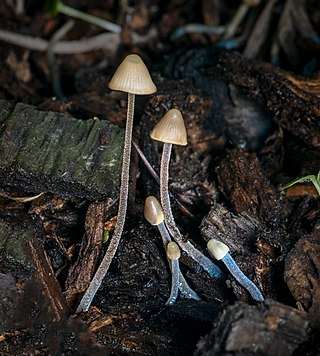
Mycena is a large genus of small saprotrophic mushrooms that are rarely more than a few centimeters in width. They are characterized by a white spore print, a small conical or bell-shaped cap, and a thin fragile stem. Most are grey or brown, but a few species have brighter colours. Most have a translucent and striate cap, which rarely has an incurved margin. The gills are attached and usually have cystidia. Some species, like Mycena haematopus, exude a latex when the stem is broken, and many species have a chlorine or radish-like odour.

Roridomyces roridus, commonly known as the dripping bonnet or the slippery mycena, is a species of agaric fungus in the family Mycenaceae. It is whitish or dirty yellow in color, with a broad convex cap 5–15 mm (0.2–0.6 in) in diameter. The stipe is covered with a thick, slippery slime layer. This species can be bioluminescent, and is one of the several causative species of foxfire.

Mycena haematopus, commonly known as the bleeding fairy helmet, the burgundydrop bonnet, or the bleeding Mycena, is a species of fungus in the family Mycenaceae, of the order Agaricales. It is widespread and common in Europe and North America, and has also been collected in Japan and Venezuela. It is saprotrophic—meaning that it obtains nutrients by consuming decomposing organic matter—and the fruit bodies appear in small groups or clusters on the decaying logs, trunks, and stumps of deciduous trees, particularly beech. The fungus, first described scientifically in 1799, is classified in the section Lactipedes of the genus Mycena, along with other species that produce a milky or colored latex.

Mycena rosea, commonly known as the rosy bonnet, is a species of bioluminescent mushroom in the family Mycenaceae. First named Agaricus roseus in 1803 by Danish botanist Heinrich Christian Friedrich Schumacher, it was given its present name in 1912 by Gramberg.

Mycena polygramma, commonly known as the grooved bonnet, is a species of mushroom in the family Mycenaceae. The inedible fruit bodies are small, pale gray-brown mushrooms with broadly conical caps, pinkish gills. They are found in small troops on stumps and branches of deciduous and occasionally coniferous trees. The mushroom is found in Asia, Europe, and North America, where it is typically found on twigs or buried wood, carrying out its role in the forest ecosystem by decomposing organic matter, recycling nutrients, and forming humus in the soil. M. polygramma contains two uncommon hydroxy fatty acids and is also a bioluminescent fungus whose intensity of light emission follows a diurnal pattern.

Mycena sanguinolenta, commonly known as the bleeding bonnet, the smaller bleeding Mycena, or the terrestrial bleeding Mycena, is a species of mushroom in the family Mycenaceae. It is a common and widely distributed species, and has been found in North America, Europe, Australia, and Asia. The fungus produces reddish-brown to reddish-purple fruit bodies with conic to bell-shaped caps up to 1.5 cm (0.6 in) wide held by slender stipes up to 6 cm (2.4 in) high. When fresh, the fruit bodies will "bleed" a dark reddish-purple sap. The similar Mycena haematopus is larger, and grows on decaying wood, usually in clumps. M. sanguinolenta contains alkaloid pigments that are unique to the species, may produce an antifungal compound, and is bioluminescent. The edibility of the mushroom has not been determined.
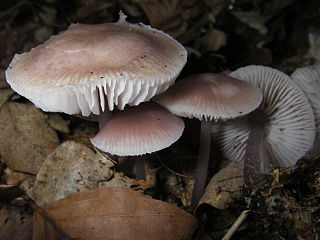
Mycena pura, commonly known as the lilac mycena, lilac bonnet, is a species of mushroom in the family Mycenaceae. First called Agaricus prunus in 1794 by Christian Hendrik Persoon, it was assigned its current name in 1871 by German Paul Kummer. Mycena pura is known to bioaccumulate the element boron.

Mycena epipterygia is a species of fungus in the family Mycenaceae of mushrooms commonly found in Europe. It is commonly known as yellowleg bonnet or yellow-stemmed mycena. The species is saprotrophic and its appearance is quite variable. For example, a number of members of the genus Mycena, some parts of the fungus are bioluminescent, including in this species, the mycelium. Mycena nivicola has been suggested as a separate species name for the Western variety.

Mycena maculata, commonly known as the reddish-spotted Mycena, is a species of fungus in the family Mycenaceae. The fruit bodies, or mushrooms, have conic to bell-shaped to convex caps that are initially dark brown but fade to brownish-gray when young, reaching diameters of up to 4 cm. They are typically wrinkled or somewhat grooved, and have reddish-brown spots in age, or after being cut or bruised. The whitish to pale gray gills also become spotted reddish-brown as they mature. The stem, up to 8 cm (3 in) long and covered with whitish hairs at its base, can also develop reddish stains. The mycelium of M. maculata has bioluminescent properties. The saprobic fungus is found in Europe and North America, where it grows in groups or clusters on the rotting wood of both hardwoods and conifers. The edibility of the fungus is unknown. Although the species is known for, and named after its propensity to stain reddish, occasionally these stains do not appear, making it virtually indistinguishable from M. galericulata.
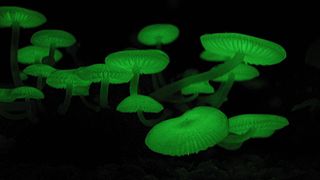
Mycena chlorophos is a species of agaric fungus in the family Mycenaceae. First described in 1860, the fungus is found in subtropical Asia, including India, Japan, Taiwan, Polynesia, Indonesia, and Sri Lanka, in Australia, and Brazil. Fruit bodies (mushrooms) have pale brownish-grey sticky caps up to 30 mm (1.2 in) in diameter atop stems 6–30 mm (0.2–1.2 in) long and up to a millimeter thick. The mushrooms are bioluminescent and emit a pale green light. Fruiting occurs in forests on fallen woody debris such as dead twigs, branches, and logs. The fungus can be made to grow and fruit in laboratory conditions, and the growth conditions affecting bioluminescence have been investigated.
Mycena asterina is a species of agaric fungus in the family Mycenaceae. It is found in São Paulo state, Brazil, where it grows singly or scattered on fallen leaves in Atlantic forests. The fruit bodies of the fungus are bioluminescent.
Mycena fera is a species of agaric fungus in the family Mycenaceae. Found in South America, the fruit bodies of the fungus are bioluminescent.
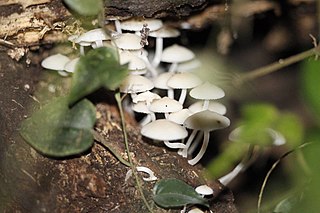
Mycena illuminans is a species of agaric fungus in the family Mycenaceae. It was first found on the trunk of Calamus (palm) in Jawa, Indonesia. It is bioluminescent.

Mycena tintinnabulum is a European species of agaric fungus in the family Mycenaceae. The mycelium, but not the fruit body, is bioluminescent.

Mycena zephirus is a species of agaric fungus in the family Mycenaceae. It is bioluminescent.
Mycena pseudostylobates is a species of agaric fungus in the family Mycenaceae. It is bioluminescent. It was originally found on the leaves of Quercus gilva in Japan.
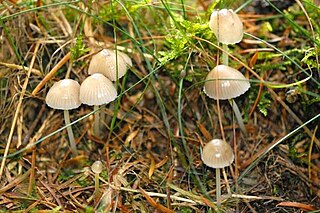
Mycena olivaceomarginata is a species of agaric fungus in the family Mycenaceae. Originally described as Agaricus olivaceomarginata by English mycologist George Edward Massee in 1890, he transferred it to Mycena in 1893. Found in Europe and North America, the mycelium of the fungus is bioluminescent.

Mycena manipularis is a species of agaric fungus in the family Mycenaceae. Found in Australasia, Malaysia, and the Pacific islands, the mycelium and fruit bodies of the fungus grow in forests and can be bioluminescent. The fruiting bodies also display a variety of morphologies that have no current genetic attributions. References to Mycena manipularis can be found in Japanese folklore and Indonesian food culture.
Mycena daisyogunensis is a species of agaric fungus in the family Mycenaceae. The fruit bodies of the fungus are bioluminescent. It was collected from Daisyogun Cave in Miyazaki Prefecture on Kyushu, Japan.















